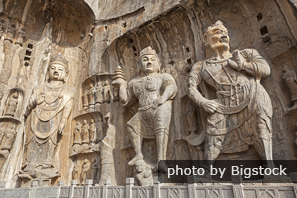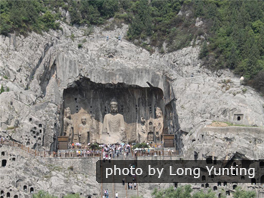Silkroads News
Longmen Grottoes
The Longmen Grottoes are on the Yi riverbank, 12 kilometers from the ancient city ofLuoyang, about 30 minutes' drive. The site is one of the three most important in China for its Buddhist sculptures and carvings; it is famous for its huge number of carvings.
There are about 2,100 grottoes and niches, over 40 crematory urns, 3,600 inscribed stone tablets and over 100,000 Buddhist images and statues. The most grottoes and caves are on the west hill, while the Xiangshan Temple and Baijuyi's (a famous Chinese ancient poet) Tomb are on the east hill.
In terms of geographical location, the magnificence of the carvings in the Longmen Grottoes ranks the first among the three most significant Buddhist sculptures (the Longmen Grottoes, the Mogao Grottoes in Dunhuang, Gansu Province in north-west China, and the Yungang Grottoes inDatong, Shaanxi Province) in China.

The Longmen Grottoes are of great value in world sculpture history and have been listed in the World Cultural Heritage Site by UNESCO. A large-scaled renovation was undertaken in 2003 to keep the grottoes in good condition. SeeAncient Grottoes in China.
Also read: Visit before It's Too Late: Seven Great Endangered Attractions in China (including Longmen Grottoes).Qianxi Temple
The Qianxi Temple is the first big cave on the west hill after walking into the Longmen scenic spot, which is famous for the flowing streams around the carvings. This 9 meters wide and high cave, which is 7 meters deep, was dug and carved in at beginning of the Tang Dynasty.
The major Buddha in this cave is Amitabha, and is about 7.38 meters high. His face is round and chubby with a smart expression and his body is in proportion. Beside him are another three Buddha figures. The most outstanding one is Mahasthamaprapta Buddha. It is the most beautiful Buddha figure built in the Tang Dynasty.
The Three Binyangdong CavesThe middle cave, north cave and south cave are the three main caves of the Binyangdong Caves. Among them, the middle cave is the most typical of caves built in the North Wei Dynasty.
The Middle CaveUnder the lotus carved on the top, Shakyamuni Buddha (the founder of Buddhism) is standing in the middle of this cave. He is slim and delicate according to the beauty standard of the North Wei Dynasty.
The front walls on both sides were embossed with a design of Buddhist stories, which has a wealth of history and art value.
Wanfo Cave (Ten Thousand Buddhists Cave) - the Smallest Grottoes
Wanfo Cave is one of the most significant caves among the Longmen Grottoes because it has the smallest Buddha figure, which is only about 2 square meters. There are 15,000 small statues of Buddha chiseled into both sides of the walls in Wanfo Cave under an exquisite colorful lotus painting on the roof.
Lotus CaveThis cave is famous for the grand lotus carving on the top, which is one of the symbols of Buddhism. It was exquisitely built in the North Wei Dynasty and has rarely been seen in the Longmen Grottoes. The five Buddha figures in this cave are Shakyamuni and his disciples.
Fengxian Temple - the Largest and Most Exquisite GrottoesNishyanda Buddha, which was built in the Tang Dynasty under the support of Wuzetian (China's first female emperor) in the Fengxian Temple, is the largest figure among the Longmen Grottoes. It is about 17 meters high. In addition, Buddha figures in the Fengxian Temple are the most exquisite and best preserved figures among the Longmen Grottoes. Travelers need to climb 99 steps to see these Buddha figures, which mean auspiciousness in Chinese.
Xiangshan Temple
Located on the east hill opposite to the grottoes, the Xiangshan Temple was originally built in the North Wei Dynasty and was rebuilt many times afterwards.
In the tablet kiosk in the Xiangshan Temple, there is a stone tablet reciting the poem written by Emperor Qianlong in the Qing Dynasty. In the south-east of the Xiangshan Temple, a two-story building called "Jiang Song Apartment" was first built as a summer residence for Jiangjieshi and Songmeiling.
Many travelers come to the Xiangshan Temple to pray for health and happiness every year. After being renovated five times, it looks more magnificent and sophisticated.
Baijuyi's TombBaijuyi's Tomb is situated on the Pipa Peak on the east hill. It is the graveyard of the famous Chinese Tang Dynasty poet, Baijuyi, who lived in Luoyang in his elderly years and loved the scenery there.
The main attractions in the graveyard are Qinggu District, Letian Hall, Poem Corridor, the Tomb District and the Book House.
Qinggu DistrictQinggu District is located between the east hill and the west hill. Inside it are a pond, kiosk, stone bridge, bamboo and white lotuses, which portray a beautiful Chinese landscape painting.
Letian HallLetian Hall was a great place for poets' get-togethers to discuss poems. The statue in this hall looks natural and under-strained. Standing in front of Letian Hall reading the poem, you can get close to the spirit world of the poet.
Poem Corridor38 stone tablets are carved with many delicate calligraphy works by famous Chinese calligraphers, which are the poems written by Baijuyi. In addition, the Japanese Calligraphy Corridor was built in 2003 for the calligraphy communication between China and Japan.
The Tomb DistrictStepping from the Peony Altar, you can reach the tomb of Baijuyi. It is surrounded by many lush cypresses, creating a solemn and respectful atmosphere.
HistoryThe grotto was first carved in the North Wei Dynasty, over 1,500 years ago, and was expanded through the succeeding East and West Wei Dynasties, North Qi Dynasty, North Zhou Dynasty, Sui and Tang Dynasties, and was finally completed in the North Song Dynasty.
500 years of renovation and expansion have created this prestigious world cultural site. The most significant chiseling activities happened in the Tang and North Wei Dynasties, which lasted over 150 years.
Travel Essentials- Location: 16 Yingcai Road, Luoyang
- Open:
- spring, summer, autumn: 7am - 6.30pm
- winter: 7.30am - 5.30pm
- Night tour: April 1st - October 10th : 6.30pm - 10pm (ticket sales stop after 9pm)
- Tel: 0379-65980972
- Ticket price: 120 yuan (including the grottoes, the Xiangshan Temple and Baijuyi's Tomb)
- Guide price: 20 yuan for an interpretation machine, 50 yuan for a tour guide
- Duration: about 2 hours
- Website: www.lmsk.cn
- Transport: Take bus 81, 53, 60, or the tourism line which departs from the Luoyang Railway Station daily.
- Note: Luoyang Peony Flower Fair is held from April 1st to May 10th. You can go to Longmen in this period as well as appreciating the peony flowers.
Category: English
News
Silkroads News
Key words:
